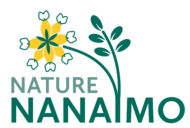A cheerful crowd of 13 Nature Nanaimo members gathered at the Morell Nature Sanctuary at 9 am. To everyone’s surprise and delight, the weather gods were in a good mood, making for a pleasant outing. The purpose of the excursion was to learn about mushrooms and other fungi from Andy, who graciously had come to Nanaimo from his home in Metchosin for a talk and a walk. We didn’t get far before the first specimens were found, and about 1 ½ hours later we had moved about 100 m, which was twice as fast as Andy’s record 100 m in 3 hours. The reason is his almost encyclopedic knowledge of plants and their fungal friends. He told us about each specimen we found, some of which were rather far gone given the date, which should have been much too late for mushroom picking. Some of the ones I remember were a species of Lactarius, which seeps a milk-coloured liquid when the gills are cut (lac = milk) and the odd looking Elfin’s saddle (Helvella sp.). The latter must be cooked in a well ventilated area to drive off volatile carcinogens if one wishes to consume it, but as it is hardly a delicacy, it would seem somewhat foolhardy to bother! Andy also spoke of the confusing phylogeny of the coprinoid fungi, which include the familiar inky cap and shaggy mane. We found a little Coprinellus sp., which prompted Andy to talk about how these have been re-arranged. The coprinoids are characterized by the complete or partial liquefying of the gills in order to spread their spores. The spores are generally black, giving the appearance of ink. This was assumed to imply relatedness, but DNA studies have revealed that it is a case of convergent evolution. See this article by Michael Kuo for more detail.
At around 10:45, Andy had to leave for other duties at home, so a few of us continued led by Morell President Bob Harvey. One of the items we talked about were the Douglas-fir “spirit stumps”. These stumps remain alive after cutting, being fed by nutrients transferred to them from surrounding trees, in large part via mycorrhizal fungi. As far as I know, this ability to heal is unique to Douglas-fir and the Pacific Northwest coast.




